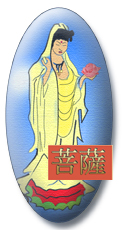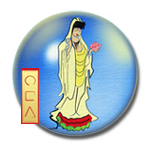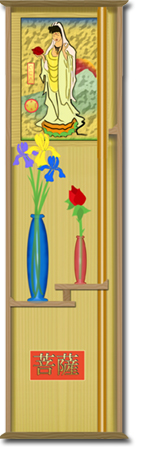On The Way: The Daily Zen Journal
Handbook for Zen Students – Part 1
Sosan 1564-1579
Preface
Those who studied Buddhism in antiquity would not speak as the Buddha had not spoken or act as the Buddha had not acted. Thus they treasured only the sacred literature of the sutras and nothing else. But for those who study Buddhism today, that which they hand on and recite are the writings of officials; that which they seek out and hold onto are the verses of those officials.

Today’s Buddhists even color their paper with red and green and decorate their buildings with fine silk. No matter how many verses they have, they are not satisfied; they consider these writings to be the greatest treasure. Alas! How can Buddhists of old and Buddhists today have such different values?
Although I am not worthy of the task, I am intent on the study of the ancient teachings and consider the sacred writings of the sutras to be a great treasure. But these writings are nonetheless numerous as leaves in thick foliage and the sea of the Tripitaka is vaster than the ocean, and it seemed that later others of the same intention would surely not be able to avoid the labor of picking through the leaves one by one, so from among the writings I have selected several hundred maxims which are the most important and to the point and wrote them down in one place.
The result can well be called concise, yet complete in meaning. If one were to take these maxims as one’s stern teacher, study thoroughly, and attain their true meaning, then there in each sentence would be a living Buddha. Do your best!
But as for a single statement which would go beyond words, an extraordinary treasure, it is not that I would not use it; it is just that I would rather reserve it for a special opportunity.
Handbook for Zen Students
1. There is one thing here. From the beginning, it is clear and bright, and divine. It has never appeared nor has it ever disappeared. Its name cannot be obtained nor can its shape be obtained.
Comment: What is this one thing?

The Sixth Patriarch once told the assembly, “I have one thing. It has no name or written symbol. Nonetheless, do any of you understand or not?”
Zen Master Shen-hui immediately stepped forward and said, “It is the original source of all the Buddhas; it is my own Buddha nature.” This is the reason Shen-hui was not the Sixth Patriarch’s true heir.
2. The Buddhas’ and patriarchs’ appearing in the world was the same as waves arising where there is no wind.
Comment: “The Buddhas and patriarchs” are those like the World Honored One and Mahakasyapa. “Appearing in the world” means that with great compassion as their essence they save all beings. But if one sees with the insight of the one thing, then each person’s face is from the beginning completely perfect. Why then make use of others to add cosmetics and put on powder? This is why their appearing in the world is raising enormous waves.
This directly shows us our original share; the Buddhas and patriarchs have no particular ability.
3. But since in Dharma there are many aspects and people have many different capacities, it does not harm to set forth expedient teachings.
Comment: “Dharma” means the one thing. “People” means sentient beings. In Dharma, there are the two aspects of immutability and changing-with-conditions. Among people, there are two kinds of capacities, some for sudden enlightenment, others for gradual cultivation. Thus there is no harm in setting forth written and spoken words.
Although I have called all beings “completely perfect,” they are born without the eye of wisdom and they submit themselves to samsara. Therefore, if not for the golden blades of the Buddhas’ and patriarchs’ appearance in the world, who would cut away the thick blinding membrane of ignorance?
This means that since beneficial new influences have been widely shown by them, one feels gratitude to the Buddhas and patriarchs for their deep kindness.
4. By force, all kinds of names have been set up, for instance “mind,” “Buddha”, or “sentient beings.” But one must not hold on to names and give rise to explanations. Right here, just as it is! If thoughts are stirred up, that is a mistake.
Comment: Forcing these three names onto the one thing is an inevitable part of the Doctrine. That it is not permissible to hold on to names and think up explanations is also an inevitable part of Zen. With one hand holding up, with the other pressing down, now setting up and now destroying all of this is the free activity of the King-of-Dharma’s Dharma commands.
This completes what is said above and introduces what is said below; it explains why the expedient teachings of the Buddhas and patriarchs are each different.
5. The World Honored One’s transmissions of mind in three places constitutes the purpose of Zen: that which he said during his entire life constitutes the path of Doctrine. Therefore, it is said that Zen is the Buddha’s mind and Doctrine is his words.
Comment: The three places of transmission are first when the Buddha shared his seat in front of the Many Children Pagoda; second, when he held up a flower in front of the assembly at Vulture Peak; and third, when under two trees he showed his two feet through his coffin. This is what is called the special transmission to Mahakasyapa of the Zen lamp.
“One lifetime” refers to the five types of Doctrine that the Buddha taught during forty-nine years (after his enlightenment.) The first is the doctrine of Earthly and Heavenly rebirth. The second is the Hinayana doctrine. The third is the Mahayana doctrine. The fourth is the Sudden doctrine. The fifth is the Perfect doctrine. That is what is called Ananda’s starting the flow of the sea of Doctrine.
Thus, the source of Zen and Doctrine is the World Honored One. The branching of Zen and Doctrine occurs with Mahakasyapa and Ananda. Using no words to reach the wordless state is Zen: using words to reach the wordless state is Doctrine. But mind is the Dharma of Zen; words are the Dharma of Doctrine. Thus, although Dharma has only one taste, views and explanations of it differ as widely as heaven and earth.
6. Therefore, if one has lost it in words (literally, in one’s mouth), then picking up a flower or smiling becomes merely the traces of Doctrine, but if one has attained it in one’s mind, then even the coarse words and petty talk of the world become the purpose of Zen which has been specially transmitted outside of Doctrine.
Comment: Since Dharma has no name, words cannot reach it. Since Dharma has no form, mind cannot reach it. One who would sum it up in words has lost original Mind. If one has lost one’s original Mind, then even though the World Honored One picks up a flower and Mahakasyapa smiles, it all falls to the level of worn-out words, and in the end it is a dead thing. For one who has attained it in one’s mind, not only common talk explains well the essential of Dharma, but even the utterings of sparrows profoundly express the Truth.
This section has elucidated the depth of Zen and the shallowness of Doctrine.
Sosan (1520-1604)
Source – Thousand Peaks Korean Zen- Tradition and Teachers by Mu Soeng Sunim 1987





The vast number of sutras, many of which have not been translated, are overwhelming in considering where to begin. In Cave 17 of the Dunhuang caves more than 10,000 manuscripts have been discovered well preserved during 900 years in the dark, dry cave. Given the sheer enormity of the writings in Buddhism, it makes perfect sense to have someone attempt to essentialize the essence of the teachings for their students and future generations.
Even so, there are always the challenges of language itself, cultural context, and the group being addressed. Given this is a handbook created for Korean Zen monks, what can we glean and then implement from it? We take what we can at the first reading, like the first point. That one point covers the entire topic, but very few people experience the one thing in its entirety.
The second point is a bit inscrutable and sounds more like a koan to contemplate what Sosan is communicating. And then we come to appreciate the benefit and need for “expedient teachings.” There are so many of us with varying life experiences and abilities to comprehend this one thing that, naturally, there must be many gateways in.
Setting the stage for the intent of the Handbook, we will present the entirety in translation over the next few months. Following Sosan as he guides us through his compilation of the most important aspects of Zen, who knows where it all may lead?
As ever,
Elana, Scribe for Daily Zen